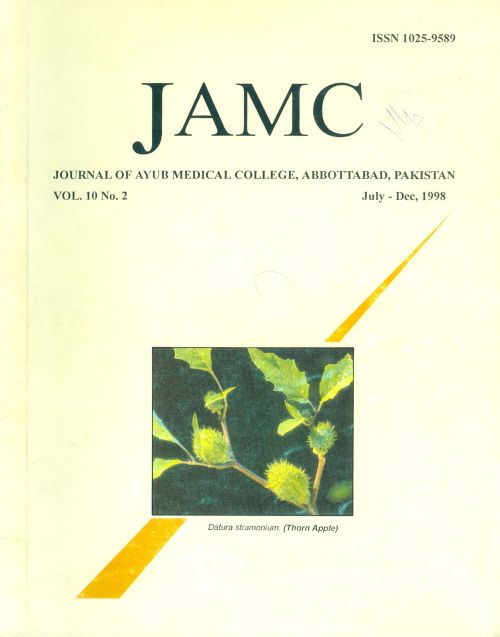THE ROLE OF SERUM AND URINARY CALCIUM LEVELS IN RENAL LITHIASIS
Abstract
Serum and urinary calcium levels play a major role in the aetio-pathogenesis of renal stoneformation. In this study, serum and 24 hours’ urinary calcium of 30 healthy controls and60patients of renal lithiasis were studied. The mean age of controls and patients was 34.9(range 3-60 years) and 37.5 years (range 3 to 70 years) respectively. The male to femaleratio of controls and patients was 1.6:1 and 1.5:1 respectively. Chemical analysis of stonesshowed 42 (70.0%) were pure calcium oxalate, 2 (3.3%) pure uric acid, while the otherswere mixed stones. Calcium was found in 58 (96.7%) stones. The overall mean + SE ofserum calcium among the controls and patients was 9.43 ± 0.14 and 9.46 ± 0.15respectively, which is statistically not significant. Although the overall values of calcium ofcontrols and patients was similar, its distribution of concentration showed that 1(3.3%)control and J1 (18.3%) patients were hypercalcemic, while 4 (13.3%) controls and19(31.7%) patients were found hypercalciuric. Idiopathic hyper-calciuria was found in3(10%) of controls as compared to 8(13.3%) patients. As hypercalciuria is the morecommon laboratory finding compared to hypercalcemia among these renal stone patients,so routine screening of 24 hours’ urinary calcium is valuable in diagnosis and aetiology ofcalcium-containing renal stones.References
Krause MV and Mahan LK. Food nutrition and diet
therapy. In: W.B Sunders company London 1984; 7:
Marshall WJ. Calcium, phosphate, magnesium and
bone. In: ±Illustrated Text Book of clinical Chemistry
±. J B Lippincott Company Philadelphia, 1984.
Hanson S. Renal stone. In: David LW, Vincent Meds.
Biochemistry in Clinical Practice Butter Worth
Heinemann Ltd, Washington 1994; p 239.
Rose GA. Calcium metabolism: Normal and abnormal
control. In, ±Scientific Foundation of Urology +.
Chisholin G D and Williams D I. (eds), London.
William Heinemann Medical Books, 1982; pp 279-292.
Coe et al. The natural history of calcium lithiasis. J Am
Med Ass 1977; 238: 1519-1523.
Bordier P, Ryckewart A, Gueris J and Rasmussen H.
On the pathogenesis of so called idiopathic
hypercalciuria. Am J Med Ass 1977; 63: 398-409.
Pak CYC, Holt. Nucleation and growth of brushite and
calcium oxalate in urine of stone formers. Metabolism;
: 665-673.
Gitelmann HJ. AN improved automatic procedure for
the determination of calcium in biochemical specimen.
Anal Biochem 1967; 18: 521-31.
Maurer C, Gotz W. Comparison of different chemical
and physical experimental methods for the analysis of
the urinary- stones in practice. Urology 1976; 16: 226.
Iguchi M, Kataoka K. Kobri K, Yachiku S, Kurita T.
Investigation of the causes of urolithiasis. Nutritional
studies in the patients with urolithiasis. Relationship of
food to excretion in the urine. Jap J Urol 1982; 73: 267.
Baker LRI, Mallinson WJW. Dietary treatment of
idiopathic hypercalciuria. Br J Urol 1979; 51: 181.
Margen S Et al. Studies in calcium metabolism The
calciuria effect of dietary protein. Am J Clin Nutrition
; 27: 584.
Johnson NE, Alcantara EN, Linkdwiler H. Effect of
level of protein intake on urinary and fecal calcium and
calcium retention of young adults males. J Nutr 1970;
: 1425.
Fellstrom B. Et al. Effects of high intake of dietary
animal’s protein on mineral metabolism and urinary
super saturation of calcium oxalate in renal stone
formers. Brit J Urol 1984: 56: 263.
Marshall VR, et al. The natural history of renal and
ureteric calculi. Br J Urol 1975; 47: 117-124.’
Robertson WG, Peacock M, Hepburn PJ, Marshall DH
and Clarke PB. Risk factors in calcium stone disease of
urinary tract. Br J Urol 1978; 50: 449-454.
Ryall RC and Marshall VR. The value of the 24-hour
urine analysis in the assessment of stone formers
attending a general hospital out-patient’s clinic. Br J
Urol 1983; 55: 1-5.
Flock RH. Calcium and phosphate excretion in the
urine of patients with renal or ureteric calculi. JAMA;
; 113: 1466.
Lemann S and Gray RW. Idiopathic hypercalciuria. J
Urol 1985; 141: 715-718’.
Rose GA and Harrison AR. The incidence investigation
and treatment of idiopathic hypercalciuria. Br. j. Urol.
; 46:261-274
Coe FL, Bushinsky DA. Pathophysiology of
hypercalciuria. American Journal of Physiology 1984;
: FI -FI 3.
Issue
Section
License
Journal of Ayub Medical College, Abbottabad is an OPEN ACCESS JOURNAL which means that all content is FREELY available without charge to all users whether registered with the journal or not. The work published by J Ayub Med Coll Abbottabad is licensed and distributed under the creative commons License CC BY ND Attribution-NoDerivs. Material printed in this journal is OPEN to access, and are FREE for use in academic and research work with proper citation. J Ayub Med Coll Abbottabad accepts only original material for publication with the understanding that except for abstracts, no part of the data has been published or will be submitted for publication elsewhere before appearing in J Ayub Med Coll Abbottabad. The Editorial Board of J Ayub Med Coll Abbottabad makes every effort to ensure the accuracy and authenticity of material printed in J Ayub Med Coll Abbottabad. However, conclusions and statements expressed are views of the authors and do not reflect the opinion/policy of J Ayub Med Coll Abbottabad or the Editorial Board.
USERS are allowed to read, download, copy, distribute, print, search, or link to the full texts of the articles, or use them for any other lawful purpose, without asking prior permission from the publisher or the author. This is in accordance with the BOAI definition of open access.
AUTHORS retain the rights of free downloading/unlimited e-print of full text and sharing/disseminating the article without any restriction, by any means including twitter, scholarly collaboration networks such as ResearchGate, Academia.eu, and social media sites such as Twitter, LinkedIn, Google Scholar and any other professional or academic networking site.









